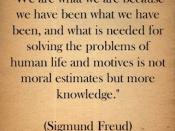Based on Sigmund Freud's "On the Universal Tendency Debasement in the Sphere of Love," Freud defines two important conceptual theories: The affectionate current and the sensual currents. The affectionate current comes from on the affection someone receives as a child from his or her primary caregiver who was most likely the man's mother or sister. Freud says that during childhood, we experience sexual instinct but they are more innocent then the sexual instincts of an adult so they manifest themselves as affection and become the affectionate current. The sensual current is different in that it develops during puberty and comes from overt sexual desires
Comparison and Contrast the psychoanalytic and trait approach to personality.
While examining Frauds theories of personality, feelings may change in accordance to the various theories. To appreciate the differences and similarities between us all, live in harmony, one must review each theory with an open mind along with the desire to learn.
A beginning place in learning and comprehending topographic theory is being aware of the three-part division of one's personality. Those parts are the preconscious, the unconscious and the conscious. The preconscious part holds a great amount of thoughts that we cannot explain. The unconscious is the part that makes up most of our personality because it contains a good number of our thoughts.
The oral and anal components of Freud's theory.
The oral stage begins when a child is born when they get the majority of their energy from their mouth. A child whose personality is firmly entrenched in this stage may manifest itself by suspicion, pessimism, or envy. These seemingly adult traits are surprising in a child but explainable according to Freud by this stage. A parent may get lucky when overindulging a child, and their young one could become in later years,


